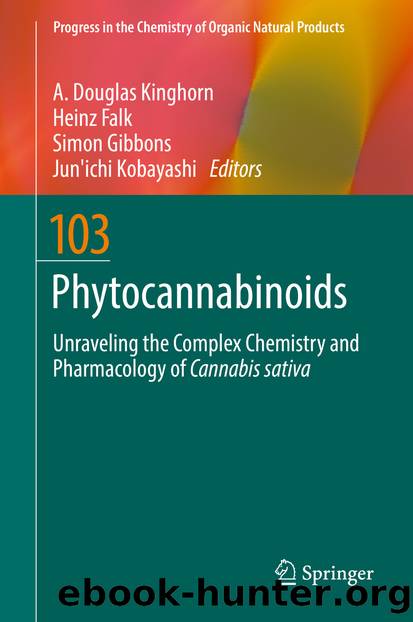Phytocannabinoids by A. Douglas Kinghorn Heinz Falk Simon Gibbons & Jun’ichi Kobayashi

Author:A. Douglas Kinghorn, Heinz Falk, Simon Gibbons & Jun’ichi Kobayashi
Language: eng
Format: epub
Publisher: Springer International Publishing, Cham
CB2
0.57
3.45
[3H] CP55-940 binding assay
Sf9 cells/Human
[159]
ND, not described; CHO, Chinese hamster ovary; COS, CV1 in origin with SV40 genes; Sf, Spodoptera frugiperda
Importantly, 1 not only activates CB1 receptors in vitro but also in vivo as well. In vivo activity of 1 at CB1 receptors was tested in a battery of animal behavior tasks known to produce outcomes associated with CB1 receptor activation [31, 32]. The four simple behavioral tests in mice known as the “Billy Martin Tetrad” were reported, and these are: inhibition of locomotor activity; reduced sensitivity to pain; reduced body temperature; and immobility (catalepsy) [31]. At doses of 0.03–20 mg kg−1 (i.v.), 1 was active in all of these tests, and the effects were blocked by the CB1 receptor antagonist, rimonabant (10 mg kg−1) [31–33]. However, it should be noted that rimonabant is not a specific ligand for the CB1 receptor when employed at concentrations of >1 μM [34, 35] and, therefore, at the concentrations reached in vivo.
With this dose, functional antagonism of these effects could also have been mediated by other targets of rimonabant such as agonism or antagonism of GPR55 receptors [36], antagonism of A1 adenosine receptors [37], and antagonism of TRPV1 channels [38].
In a feeding study in rats, 1 (0.5–4.0 mg kg−1) stimulated hyperphagia. However, while rimonabant predictably inhibited hyperphagia at doses of >0.67 mg kg−1, it also stimulated hyperphagia at lower doses. There was no significant difference in food intake between these two groups and this may be due to the differences in the feeding pattern being masked by effects on non-specific behavioral effects such as reduced motor co-ordination induced by 1 treatment [39].
There is also in vitro and in vivo evidence that 1 binds to, and activates the CB2 receptor. The binding affinity of 1 at CB2 receptors is, however, lower than that at CB1 receptors, as shown in Table 2 [29, 40]. Evidence of a partial agonist effect of 1 at CB2 receptors came from a study where 1 antagonized the inhibition of adenylate cyclase in CHO cells transfected with human CB2 receptors induced by the agonists HU-293a and HU-210 (Table 2) [40].
As is typical of a partial agonist, 1 has a mixed agonist–antagonist effect. This is likely dependent on the proportion of cannabinoid receptors that are in the “active” state in tissues, coupled to their effector mechanisms, or in the “inactive” state, uncoupled to their effector mechanisms [41]. Moreover, it would also depend on the presence of other synthetic or endogenous cannabinoid receptor agonists, and possibly species differences between studies. As a partial agonist, 1 can be expected to antagonize the actions of full agonists. In a mouse model of hypothermia, 1 alone acted as a partial agonist with less efficacy than the cannabinoid receptor full agonist, AM2389, but when co-administered with this compound, 1 antagonized AM2389’s hypothermic effects [42].
In an in vitro study using the GTPγS binding assay in rat brain membranes from rats chronically treated with 10 mg kg−1 1 for 21 days, the stimulation of GTPγS binding by WIN
Download
This site does not store any files on its server. We only index and link to content provided by other sites. Please contact the content providers to delete copyright contents if any and email us, we'll remove relevant links or contents immediately.
The Art of Coaching by Elena Aguilar(52202)
Thinking, Fast and Slow by Kahneman Daniel(11802)
The Art of Thinking Clearly by Rolf Dobelli(9929)
The 5 Love Languages: The Secret to Love That Lasts by Gary Chapman(9293)
Mindhunter: Inside the FBI's Elite Serial Crime Unit by John E. Douglas & Mark Olshaker(8708)
When Breath Becomes Air by Paul Kalanithi(8043)
Periodization Training for Sports by Tudor Bompa(7929)
Becoming Supernatural by Dr. Joe Dispenza(7845)
Turbulence by E. J. Noyes(7708)
Bodyweight Strength Training by Jay Cardiello(7680)
Therapeutic Modalities for Musculoskeletal Injuries, 4E by Craig R. Denegar & Ethan Saliba & Susan Saliba(7601)
The Road Less Traveled by M. Scott Peck(7284)
Nudge - Improving Decisions about Health, Wealth, and Happiness by Thaler Sunstein(7255)
Mastermind: How to Think Like Sherlock Holmes by Maria Konnikova(6942)
Enlightenment Now: The Case for Reason, Science, Humanism, and Progress by Steven Pinker(6878)
Win Bigly by Scott Adams(6831)
Kaplan MCAT General Chemistry Review by Kaplan(6603)
Why We Sleep: Unlocking the Power of Sleep and Dreams by Matthew Walker(6362)
The Way of Zen by Alan W. Watts(6292)
